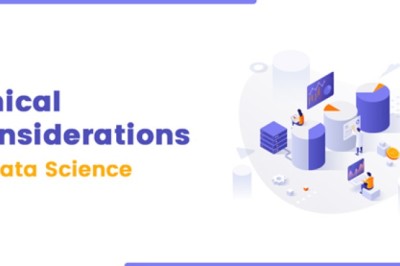views
Similar to physical hardware, the software can be a product that needs to be procured from multiple suppliers. The challenge is that there are many different types of software, all with varying degrees of complexity and customization. This makes it difficult to track the different pieces of software that make up a solution and how they relate to each other.
Especially when there are hundreds or even thousands of different software components across an organization, it can become difficult to manage them. The solution is to take the same approach that businesses use with physical hardware: create a software supply chain.
What is a software supply chain?
A software supply chain is a network of organizations and individuals that work together to produce and distribute software. Software supply chains have many of the same characteristics as other types of supply chains, such as food and automotive. They are complex and highly interconnected, with a large number of participants. They also undergo frequent changes, including new products and services, new technologies, and business models.
The main difference between a software supply chain and other types of supply chains is that it involves intangible products, such as software applications or data. The goal of a software supply chain is to produce and distribute software efficiently and effectively while ensuring that customers receive the products they need.
It's an important part of any business because it helps to ensure quality and performance, reduces errors and waste, and improves time-to-market. Since software supply chains are interconnected, they consist of a number of different stakeholders and departments that are responsible for different parts of the process.
What are the components of a software supply chain?
The software supply chain is a complex network that transforms ideas and code into products, from design to distribution. The role of each member within the supply chain varies, but they all play a critical role in ensuring that the products are ready for market. The basic structure of a software supply chain includes the following:
Software design and procurement.
The first step of the software supply chain is to design and procure the software. This process involves creating a vision for the product, deciding on its features, and then allocating resources to develop it. It also involves the procurement of specific technologies, such as coding languages, frameworks, and development environments.
Software development and testing.
The second step of the software supply chain is to develop the software. This involves writing code, unit testing it, and assembling all of the components into a final product. This step often involves multiple developers working on different modules of the product, which means that it can be challenging to coordinate their work.
Following this, the software needs to be tested to make sure that it works correctly and meets the requirements laid out in the project plan. Especially for large projects, this can be a laborious process that requires the assistance of quality assurance teams.
Distribution.
Once the software is ready for release, it must be distributed to users. This may involve a number of different tasks, including creating installation packages for various operating systems and devices, writing documentation for end-users, and coordinating with software vendors for supply chain financing or marketing.
This step also involves making sure that users can access and receive the software, and that they have access to the information and support they need to make sure the software works as intended.
Maintenance and support.
Even once a project is complete, it will need to be maintained. This includes fixing bugs as they are discovered and updating the software to work with new versions of operating systems or other dependencies. It’s also important to provide regular updates to users so that they can take advantage of new features and improvements.
What are the best optimization strategies for a software supply chain?
Software supply chains are dynamic systems that need to be constantly analyzed and optimized in order to keep up with the changing needs of users and IT professionals.
Companies need to have a clear understanding of the impact that each action has on their supply chain, including how changes affect both internal processes and external relationships. Here are some strategies for optimizing a software supply chain:
Invest in staff training.
It’s important for a team to understand the challenges and opportunities of the software supply chain. They need to know how each action impacts the entire system, and how changes will affect the company’s ability to deliver quality goods and services.
The better the team understands these concepts, the better they can identify and implement strategies to help optimize the software supply chain. This can include things like training and development programs, as well as more hands-on approaches like mentorship and coaching.
Data encryption.
Data encryption is one of the most important steps you can take to help maximize software supply chain security. By encrypting data, you’re protecting it from unauthorized access, which will prevent hackers from accessing sensitive information or tampering with products.
Having an automated process in place for data encryption ensures that all data is encrypted at rest and in transit, which makes it much more difficult to steal information or damage systems via malware.
Establish security-first development practices.
Security-first development practices are the foundation of a secure software supply chain. It’s important that all software development teams have a strong understanding of security best practices and a culture of security. This includes designing secure software from the ground up, testing the code to make sure it is not vulnerable, and incorporating security measures into every aspect of the supply chain.
Not only can these practices help prevent security breaches, but they also improve the overall quality of software, which can lead to increased customer satisfaction and higher adoption rates.
Use automation tools and software.
Automation tools are a great way to reduce costs, increase efficiency, improve quality, and reduce risk. In software supply chains, automation tools can be used to help better create, test, and deploy software. They can also be used to identify security vulnerabilities in code before it is delivered to customers.
These automated tools are assets for organizations looking to reduce costs by eliminating manual processes that are prone to human error and provide a better return on investment by ensuring that the right testing procedures are followed every time.
Manage access and identities.
It’s important that a company has strong access control and identity management practices in place. This includes having a centralized system for managing user accounts, which can help reduce security risks by ensuring that only authorized personnel have access to sensitive data.
It also includes monitoring all logins with an alerting system so you know when someone attempts unauthorized access or when there’s an attempt to use credentials from an unknown device or location. By limiting access to the right people and monitoring activity, companies can help reduce the risk of fraud and cyberattacks.
In Summary
Software supply chains can be a complex operation, especially with many different parties involved. With the increase in complexity comes an increase in risk that can be mitigated through careful planning and execution.
This is why it’s critical to have a system in place that can help better manage the supply chain, from planning to delivery and beyond. And while software supply chains may be complicated, abiding by some key guiding principles can help companies manage the risks and ensure a smoother operation.






















Comments
0 comment